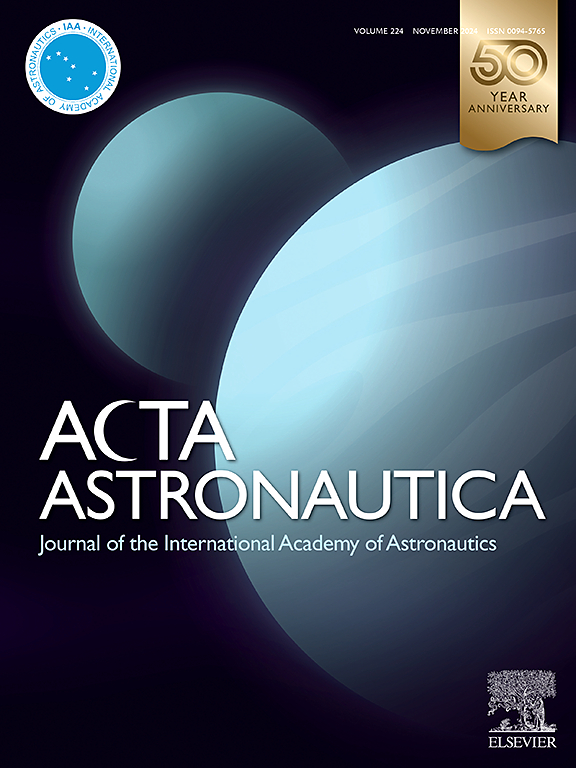采用多标准决策方法评估阿特米斯三号任务的潜在着陆点
IF 3.1
2区 物理与天体物理
Q1 ENGINEERING, AEROSPACE
引用次数: 0
摘要
在阿特米斯探索区(AEZ)内选择着陆点涉及多种因素,是一个复杂的问题。本研究结合地理信息系统(GIS)和多标准决策(MCDM)方法,特别是TOPSIS算法,对阿耳特弥斯III号任务的潜在着陆点进行了评估。通过整合月球的地形、光照和矿物学数据,我们评估了 13 个候选区域内符合人类着陆系统(HLS)要求的 1247 个地点,以及靠近月球南极的 004 号站点。考虑的标准包括表面能见度、HLS-宇航员视线、永久阴影区(PSRs)、阳光照射、与地球的直接通信、地质单元和岩浆矿物丰度。DM2站点(Nobile Rim 2),特别是位于南纬84°12'5.61"(-84.20156°)和东经60°41'59.61"(60.69989°)的点,是着陆的最佳位置。灵敏度分析证实了我们方法的稳健性,验证了最佳地点的适用性,尽管采用了 MCDM 方法,并改变了优先考虑光照和 PSR 的标准权重。这项研究证明了 GIS-MCDM 技术在月球探测中的适用性,以及它们能为 Artemis 计划带来的潜在益处。本文章由计算机程序翻译,如有差异,请以英文原文为准。
Evaluating potential landing sites for the Artemis III mission using a multi-criteria decision making approach
The selection of a landing site within the Artemis Exploration Zone (AEZ) involves multiple factors and presents a complex problem. This study evaluates potential landing sites for the Artemis III mission using a combination of Geographic Information Systems (GIS) and Multi-Criteria Decision Making (MCDM) methodologies, specifically the TOPSIS algorithm. By integrating topographic, illumination, and mineralogy data of the Moon, we assess 1247 locations that meet the Human Landing System (HLS) requirements within 13 candidate regions and Site 004 near the lunar south pole. Criteria considered include surface visibility, HLS-astronaut line of sight, Permanently Shadowed Regions (PSRs), sunlight exposure, direct communication with Earth, geological units, and mafic mineral abundance. Site DM2 (Nobile Rim 2), particularly the point at latitude 84°12’5.61”S (−84.20156°) and longitude 60°41’59.61”E (60.69989°), is the optimal location for landing. Sensitivity analysis confirms the robustness of our approach, validating the suitability of the best location despite the MCDM method employed and variations in criteria weightings to prioritize illumination and PSRs. This research demonstrates the applicability of GIS-MCDM techniques for lunar exploration and the potential benefits they can bring to the Artemis program.
求助全文
通过发布文献求助,成功后即可免费获取论文全文。
去求助
来源期刊

Acta Astronautica
工程技术-工程:宇航
CiteScore
7.20
自引率
22.90%
发文量
599
审稿时长
53 days
期刊介绍:
Acta Astronautica is sponsored by the International Academy of Astronautics. Content is based on original contributions in all fields of basic, engineering, life and social space sciences and of space technology related to:
The peaceful scientific exploration of space,
Its exploitation for human welfare and progress,
Conception, design, development and operation of space-borne and Earth-based systems,
In addition to regular issues, the journal publishes selected proceedings of the annual International Astronautical Congress (IAC), transactions of the IAA and special issues on topics of current interest, such as microgravity, space station technology, geostationary orbits, and space economics. Other subject areas include satellite technology, space transportation and communications, space energy, power and propulsion, astrodynamics, extraterrestrial intelligence and Earth observations.
 求助内容:
求助内容: 应助结果提醒方式:
应助结果提醒方式:


